Abstract
The spontaneously hypertensive rat (SHR) has been proposed as an animal model for attentiondeficit disorder (ADHD). The behavioural problems have been suggested to be secondary to altered reinforcement mechanisms in which nucleus accumbens dopaminergic activity plays an important role. Interaction between the noradrenergic and dopaminergic system in the nucleus accumbens has been implicated in the locomotor hyperactivity and impaire discriminative performance of SHR. The present study therefore investigated whether there was any change in the α2-adrenoceptor mediated inhibition of dopamine release from nucleus accumbens slices of SHR in comparison with their normotensive Wistar-Kyoto (WKY) controls. The electrically stimulated release of [3H]dopamine (DA) from nucleus accumbens slices was decreased to a similar extent by UK14,304, an α2-adrenoceptor agonist, in SHR and WKY. Basal norepinephrine (NE) levels were increased in locus coeruleus (LC) and A2 noradrenergic nuclei, but not in the A1 nucleus of SHR, while basal serotonin (5-HT) levels were increased in all these pons-medulla nuclei. These results suggest that a primarily dysfunctional LC and A2 nucleus does not have a secondary effect on dopaminergic transmission in the nucleus accumbens via α2-adrenoceptor mediated inhibition of DA release. Basal monoamine levels in several brain areas of SHR were significantly different from that of WKY. DA, and 5-HT turnover were decreased in SHR versus WKY suggesting hypofunctional dopaminergic and serotonergic systems in some brain areas of SHR.
Similar content being viewed by others
References
Sonuga-Barke, E. J., Taylor, E., Sembi, S., and Smith, J. 1992. Hyperactivity and delay aversion. I. The effect of delay on choice. J. Child Psychol. Psychiatry 30:387–398.
Safer, D. J., and Krager, J. M. 1988. A survey of medication treatment for hyperactive/inattentive students. JAMA, 260:2256–2258.
Faraone, S. V., Biederman, J., Lehman, B. K., Keenan, K., Norman, D., Seidman, L. J., Koloday, R., Kraus, I., Perrin, J., and Chen, W. J. 1993. Evidence for the independent familial transmission of attention deficit hyperactivity disorder and learning disabilities: Results from a family genetic study. Am. J. Psychiat. 150:891–895.
Sagvolden, T, and Archer, T. 1989. Future perspectives on ADD research—An irresistible challenge. Pages 369–389,in Sagvolden T., and Archer, T. (eds.), Attention defici disorder: Clinical and basic research, Lawrence Erlbaum Associates, Hillsdale, New Jersey.
Sagvolden, T., Hendley, E. D., and Knardahl, S. 1992. Behavior of hypertensive and hyperactive rat strains: Hyperactivity is not unitarily determined. Physiol. Behav. 52:49–57.
Sagvolden, T., Metzger, M. A., Schiøbeck, H. K., Rugland, A.-L., Spinnagr, I., and Sagvolden, G. 1992. The spontaneously hypertensive rat (SHR) as an animal model of childhood hhperactivity (ADHD): Changed reactivity to reinforcers and to psychomotor stimulants. Behav. Neural Biol. 58:103–112.
McCullough, L. D., Cousins, M. S., and Salamone, J. D. 1993. The role of nucleus accumbens dopamine in responding on a continuous reinforcement operant schedule: A neurochemical and behavioral study. Pharmacol. Biochem. Behav. 46:581–586.
McKeon, T. W., and Hendley, E. D. 1988. Brain monoamines and metabolites in hypertensive and hyperactive rat strains. Clin. Exp. Hypertens. 10:971–994.
Tsuda, K., Tsuda, S., Masuyama, Y., and Goldstein, M. 1991. Alterations in catecholamine release in the central nervous system of spontaneously hypertensive rats. Jpn. Heart J. 32:701–709.
Fuller, R. W., Hemrick-Luecke, S. K., Wong, D. T., Pearson, D., Threlkeld, P. G., and Hynes, M. D. 1983. Altered behavioral response to a D2 agonist, LY141865 in spontaneously hypertensive rats exhibiting biochemical and endocrine responses similar to those in normotensive rats. J. Pharmacol. Exp. Ther. 227:354–359.
Van den Buuse, M., Jones, C. R., and Wagner, J. 1992. Brain dopamine D-2 receptor mechanisms in spontaneously hypertensive rats. Brain Res. Bull. 28:289–297.
Russell, V. A., Lamm, M. C. L., Allin, R., de Villiers, A. S., Searson, A., and Taljaard, J. J. F. 1989. Effect of selective noradrenergic denervation on noradrenaline content and [3H]dopamine release in rat nucleus accumbens slices. Neurochem. Res. 14:169–172.
Cole, B. J., and Robbins, T. W. 1987. Amphetamine impairs the discriminative performance of rats with dorsal noradrenergic bundle lesions on a 5-choice serial reaction time task: New evidence for dopaminergic-noradrenergic interactions. Psychopharmacology 91:458–466.
Allin, R., Russell, V. A., Lamm, M. C. L., and Taljaard, J. J. F. 1988. Regional distribution of monoamines in the nucleus accumbens of the rat. Neurochem. Res. 13:937–942.
Nurse, B., Russell, V. A., and Taljaard, J. J. F. 1984. α2 and β-adrenoceptor agonists modulate [3H]dopamine release from rat nucleus accumbens slices: Implications for research into depression. Neurochem. Res. 9:1231–1238.
Russell, V. A., Lamm, M. C. L., and Taljaard, J. J. F. 1993. Lack of interaction between α2-adrenoceptors and dopamine D2-receptors in mediating their inhibitory effects on [3H]dopamine release from rat nucleus accumbens slices. Neurochem. Res. 18:285–289.
Burton, P. G., and Levy, F. 1991. The neuropharmacology of attention deficit disorder. Biol. Psychiatr. 29:608S.
Hellstrand, K., and Engel, J. 1980. Locomotor activity and catecholamine receptor binding in adult normotensive and spontaneously hypertensive rats. J. Neural Trasmission 48:57–63.
Kawasaki, S., Takeda, K., Tanaka, M., Itoh, H., Hirata M., Nakata, T., Hayashi, J., Oguro, M., Sasaki, S., and Nakagawa, M. 1991. Enhanced norepinephrine release in hypothalamus from locus coeruleus in SHR. Jpn. Heart J. 32:255–262.
Ghosh, D., Anyanwu, B. O., Guilford, J., and Henderson, L. L. 1991. Effects of L-tryptophan on the brainstem indole and catecholamine metabolites in spontaneously hypertensive rats. Pages 615–617,in R. Schwarcz et al., (eds.), Kynurenine and 5-HT Pathways, Plenum Press, New York.
Nagaoka, A., and Lovenberg, W. 1977. Regional changes in the activities of aminergic biosynthetic enzymes in the brains of hypertensive rats. Eur. J. Pharmacol. 43:297–306.
Versteeg, D. H. G., Palkovits, M., Van den Gugten, J., Wijnen, H. L. J. M., Smeets, G. W. M., and De Jong, W. 1976. Catecholamine content of individual brain regions of spotaneously hypertensive rats (SH-rats). Brain Res. 112:429–434.
Takami, T., Ito, H., and Suzuki, T. 1993. Decreased norepinephrine content in the medulla oblongata in severely hypertensive rats. Clin. Exp. Pharmacol. Physiol. 20:161–167.
Saavedra, J. M., Grobecker, H., and Axelrod, J. 1978. Changes in central catecholaminergic neurons in the spontaneously (genetic) hypertensive rat. Circulation Res. 42:529–534.
Olmos, G., Miralles, A., Barturen, F., and Garcia-Sevilla, J. A. 1991. Decreased density and sensitivity of α2-adrenoceptors in the brain of spontaneously hypertensive rats. Eur. J. Pharmacol. 205: 93–96.
Cambridge, D. 1981. UK14,304, a potent and selective α2-agonist for the characterization of α-adrenocepto subtypes. Eur. J. Pharmacol. 72:413–415.
Mintz, M., Reyneke, L., de Villiers, A., Allin, R., Russell, V., Daniels, W., van der Spuy, G., Jaffer, A., Kellaway, L., Douglas, R., and Taljaard, J. 1992. Effect of amygdaloid kindling on [3H]dopamine and [14C]acetylcholine release from rat prefrontal cortex and striatal slices. Brain Res. 592:115–121.
Palkovits, M., and Brownstein, M. J. 1988. Maps and guide to microdissection of the rat brain. 1st ed. Elsevier, New York.
Hetey, L., and Zimmerman, B. 1986. Characterization of the synaptosomal high-affinity uptake of noradrenaline in the nucleus accumbens of rats. Biomed. Biochim. Acta 45:1203–1207.
Hyttel, J., and Larsen, J.-J. 1985. Serotorin-selective antidepressants. Toxicol. 56:146–153.
Kostowski, W. 1980. Noradrenergic interactions among central neurotransmitters. Pages 47–65, in: Essman, W. B. (ed.), Neurotransmitters, Receptors and Drug Action, Spectrum Publ. Inc., New York.
Cousins M. S., Sokolowski, J. D., and Salamone, J. D. 1993. Different effects of nucleus accumbens and ventrolateral striatal dopamine depletions on instrumental response selection in the rat. Pharmacol. Biochem. Behav. 46:943–951.
Kelley, P. H., Seviour, P. W., and Iversen, S. D. 1975. Amphetamine and apomorphine responses in the rat following 6-OHDA lesions of the nucleus accumbens. Brain Res. 94:507–522.
Linthorst, A. C. E., Van den Buuse, M., De Jong, W., and Versteeg, D. H. G. 1990. Electrically-stimulated [3H]dopamine and [14C]acetylcholine release from nucleus caudate slices: differences between spontaneously hyperactive rats and Wistar-Kyoto rats. Brain Res. 509:266–272.
Kirouac, G. J., and Ganguly, P. K. 1993. Up-regulation of dopamine receptors in the brain of the spontaneously hypertensive rat: an autoradiographic analysis. Neurosci. 52:135–141.
Myers, M. M., Whittemore, S. R., and Hendley, E. D. 1981. Changes in catecholamine neural uptake and receptor binding in the brains of spontaneously hypertensive rats (SHR). Brain Res. 220:325–338.
McRae-Degueurce, A., and Milon, H. 1983. Serotonin and dopamine afferents to the rat locus coeruleus: a biochemical study after lesioning of the ventral mesencephalic tegmental-A10 region and raphe dorsalis. Brain Res. 263:344–347.
Takaori, S., Tanaka, C., and Okamoto, K. 1972. Relationship between behaviour and brain monoamines in spontaneously hypertensive rats. Pages 89–92,in Okamoto, K. (ed.), Spontaneous Hypertension: Its Pathogenesis and Complications, Igaku Shoin, Tokyo.
McCarty, R., Chiueh, C. C., and Kopin, I. J. 1980. Differential behavioral responses of spontaneously hypertensive (SHR) and normotensive (WKY) rats to d-amphetamine. Pharmacol. Biochem. Behav. 12:53–59.
Author information
Authors and Affiliations
Rights and permissions
About this article
Cite this article
de Villiers, A.S., Russell, V.A., Sagvolden, T. et al. β2 Mediated inhibition of [3H]dopamine release from nucleus accumbens slices and monoamine levels in a rat model for attention-deficit hyperactivity disorder. Neurochem Res 20, 427–433 (1995). https://doi.org/10.1007/BF00973098
Accepted:
Issue Date:
DOI: https://doi.org/10.1007/BF00973098




